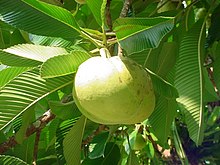bio.wikisort.org - Plant
Dillenia indica, commonly known as elephant apple,[2] is a species of Dillenia native to China and tropical Asia.[2]

| Dillenia indica | |
|---|---|
 | |
 | |
| Leaves, fruits & buds in West Bengal, India | |
Conservation status | |
| Scientific classification | |
| Kingdom: | Plantae |
| Clade: | Tracheophytes |
| Clade: | Angiosperms |
| Clade: | Eudicots |
| Order: | Dilleniales |
| Family: | Dilleniaceae |
| Genus: | Dillenia |
| Species: | D. indica |
| Binomial name | |
| Dillenia indica | |
Description
It is an evergreen large shrub or small to medium-sized tree growing to 15 m tall. The leaves are 15–36 cm long, with a conspicuously corrugated surface with impressed veins. Its branches are used to make good firewood. The flowers are large, 15–20 cm diameter, with five white petals and numerous yellow stamens. Its characteristic round fruits are large, greenish yellow, have many seeds and are edible. The fruit is a 5–12 cm diameter aggregate of 15 carpels, each carpel containing five seeds embedded in an edible but fibrous pulp.[3][4]
Taxonomy
Dillenia indica was one of the many species first described by Linnaeus in the 10th edition of his Systema Naturae in 1759.[5]
Ecology
Dillenia indica produces a large hard edible[3] fruit which is accessible only to the megaherbivores in the wild. A study in the Buxa Tiger Reserve by ecologists Sekar & Sukumar has shown that Asian elephants appear to have a particular fondness for the fruits of D. indica, and are hence an important seed disperser for this tree. With the prospect of extinction of the elephants this tree has developed a back-up system, whereby its hard fruits that were only accessible to megaherbivores, slowly soften on the forest floor through the dry season to allow access to successively smaller animals such as macaques, rodents and squirrels. Seeds from both old and soft fruits are able to germinate well, enabling the persistence of this tree to be independent of the survival of its major megaherbivore disperser.[6]
Uses
The fruit pulp is sour and used in Indian cuisine in curries, jam (ouu khatta), and jellies.[3]
Because it is a main source of food for elephants, monkeys and deer, collection of fruit from the core areas of the forest is prohibited. Commercial sale of the fruit is also prohibited, in an effort to help keep the food-chain system of the forest from dismantling totally.[7]

References
- Oldfield, S. (2020). "Dillenia indica". IUCN Red List of Threatened Species. 2020: e.T61994577A61994579. doi:10.2305/IUCN.UK.2020-2.RLTS.T61994577A61994579.en. Retrieved 19 November 2021.
- "Dillenia indica". Germplasm Resources Information Network (GRIN). Agricultural Research Service (ARS), United States Department of Agriculture (USDA). Retrieved 6 May 2019.
- Huxley, A., ed. (1992). New RHS Dictionary of Gardening. Macmillan ISBN 0-333-47494-5.[page needed]
- Flora of Pakistan: Dillenia indica
- Linnaeus, Carl (1758). Systema Naturae per Regna Tria Naturae, Secundum Classes, Ordines, Genera, Species, cum Characteribus, Differentiis, Synonymis, Locis (in Latin). Vol. 2 (10th revised ed.). Holmiae: (Laurentii Salvii). p. 1082.
- Sekar, Nitin; Sukumar, Raman; Leishman, Michelle (2013). "Waiting for Gajah: an elephant mutualist's contingency plan for an endangered megafaunal disperser". Journal of Ecology. 101 (6): 1379–88. doi:10.1111/1365-2745.12157.
- Sumanta Ray Chaudhuri (21 June 2007). "Elephants and villagers fight over pickle fruit". DNA.
На других языках
- [en] Dillenia indica
[ru] Чалта
Чалта, или Дилле́ния инди́йская[1] (лат. Dillenia indica) — вечнозелёное дерево семейства Диллениевые, высотой до 15 м, происходящее из Юго-Восточной Азии, Индии и Шри-Ланки. Листья 15-36 см длиной, с рифлёной поверхностью и выделяющимися жилками. Цветки большие 15-20 см диаметром с белыми лепестками и многочисленными жёлтыми тычинками. Плод сложный, состоящий из 15 увеличенных в размерах плодолистиков, содержащих по 5 семян и окружающих их сильно разросшихся мясистых чашелистиков. Диаметр плода варьирует от 5 до 12 см. Фруктовая мякоть съедобна и широко используется в индийской кухне. Из неё приготавливают карри, джемы и желе.Другой контент может иметь иную лицензию. Перед использованием материалов сайта WikiSort.org внимательно изучите правила лицензирования конкретных элементов наполнения сайта.
WikiSort.org - проект по пересортировке и дополнению контента Википедии
